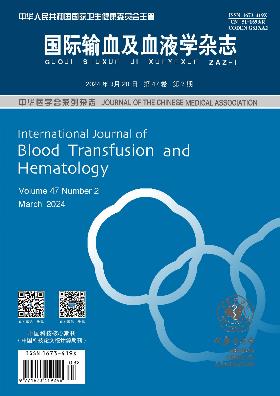Correlation between HLA-E*01∶03 positive genotype and acute leukemia
引用次数: 0
Abstract
Objective To analyze relationship between positive genotype of human leukocyte antigen(HLA)-E*01∶03 and acute leukemia (AL). Methods From January 2013 to December 2015, a total of 136 patients with AL who underwent blood group matching at Shenzhen Blood Center were included in this study as AL group. Among them, there were 78 male patients and 58 females; the age was (39±23) years. A simple random sampling method was used to select 182 health blood donors who participated in voluntary blood donation at the Shenzhen Blood Center in the same period. Among them, there were 101 male donors and 71 females; and age was (38±19) years. The sequence of exon 3 of HLA-E gene was determined by PCR-sequence based typing (SBT) method, and the genotype of HLA-E gene was determined. The peripheral blood lymphocytes from 54 patients in AL group and 64 healthy blood donors in control group were separated by density gradient centrifugation. The relative expressions of HLA-E on lymphocytes were detected by flow cytometry. The expression levels of plasma soluble HLA (sHLA)-E from 54 patients in AL group and 64 healthy blood donors in control group were detected by enzyme-linked immunosorbent assay (ELISA). The genotype frequencies of subjects in the two groups were compared by Chi-square test. The relative expression levels of HLA-E on peripheral blood lymphocytes and the expression level of sHLA-E in plasma were compared by independent samples t test, respectively. This study was in line with the procedures followed in this study were in accordance with the standards established by the Medical Ethics Committee of the Shenzhen Blood Center, and this study was approved by the committee (Approval No. SZBC-2017-007). All the subjects signed the informed consents for clinical trials and informed contents were obtained from all subjects. Results ① The genotype frequency of HLA-E*01∶03 positive genotype was 90.4% (123/136) of patients in AL group, which was higher than that of 77.5% (141/182) in control group, and the difference was statistically significant (χ2=9.286, P=0.002). ② Among the 54 patients in AL group and the 64 healthy blood donors in control group, the difference of relative expression levels of HLA-E on peripheral blood lymphocytes from subjects with HLA-E*01∶03 positive genotype between the two groups were not statistically significant [(3.3±0.4) vs (3.6±0.2); t=0.77, P=0.440]. The relative expression level of HLA-E on peripheral blood lymphocytes from patients with HLA-E*01∶03 negative genotype in AL group was (1.6±0.2), which was lower than that of (2.5 ± 0.2) in control group, and the difference was statistically significant (t=2.95, P=0.010). ③ Among 54 patients in AL group and 64 healthy blood donors in control group, the expression level of sHLA-E in plasma from patients with HLA-E*01∶03 positive genotype in AL group was (31.2±0.4 ) pg/mL, which was higher than that of (18.2±0.3) pg/mL in control group, and the difference was statistically significant (t=26.63, P<0.001). The expression level of sHLA-E in plasma from patients with HLA-E*01∶03 negative genotype in AL group was (32.9±1.3) pg/mL, which was lower than that of (18.8±0.8) pg/mL in the control group, and the difference was also statistically significant (t=8.89, P<0.001). Conclusions The HLA-E*01∶03 positive genotype frequency and the expression of sHLA-E in plasma have a certain correlation with AL. They may be a potential predictor and an auxiliary diagnostic indicator for AL. Key words: Leukemia, myeloid, acute; Leukemia, lymphoid; Genes, MHC class Ⅰ; Genotype; Human leukocyte antigen-EHLA-E*01∶03阳性基因型与急性白血病的相关性
目的分析人白细胞抗原(HLA)-E*01∶03阳性基因型与急性白血病(AL)的关系。方法选取2013年1月至2015年12月在深圳市血液中心进行血型配型的AL患者136例作为AL组。其中男性78例,女性58例;年龄(39±23)岁。采用简单随机抽样的方法,选取同期在深圳市血液中心参加无偿献血的182名健康献血者。其中男性献血者101例,女性71例;年龄(38±19)岁。采用pcr -序列分型(SBT)法测定HLA-E基因外显子3的序列,确定HLA-E基因的基因型。采用密度梯度离心分离法分离54例AL组患者和64例健康献血者的外周血淋巴细胞。流式细胞术检测HLA-E在淋巴细胞上的相对表达。采用酶联免疫吸附试验(ELISA)检测54例AL组患者和64例正常对照组的血浆可溶性HLA (sHLA)-E的表达水平。两组受试者基因型频率比较采用卡方检验。外周血淋巴细胞HLA-E的相对表达水平和血浆sHLA-E的相对表达水平分别采用独立样本t检验进行比较。本研究遵循深圳市血液中心医学伦理委员会制定的标准,并经委员会批准(批准号:szbc - 2017 - 007)。所有受试者均签署了临床试验知情同意书,并获取了所有受试者的知情内容。结果①AL组患者HLA-E*01∶03基因型阳性频率为90.4%(123/136),高于对照组的77.5%(141/182),差异有统计学意义(χ2=9.286, P=0.002)。②54例AL组患者与64例健康献血者对照组中,HLA-E*01∶03基因型阳性患者外周血淋巴细胞HLA-E相对表达量两组间差异无统计学意义[(3.3±0.4)vs(3.6±0.2)];t = 0.77, P = 0.440)。AL组HLA-E*01∶03阴性基因型患者外周血淋巴细胞HLA-E相对表达量为(1.6±0.2),低于对照组的(2.5±0.2),差异有统计学意义(t=2.95, P=0.010)。③AL组54例患者和对照组64例健康献血者中,AL组HLA-E*01∶03基因型阳性患者血浆中sHLA-E的表达水平为(31.2±0.4)pg/mL,高于对照组(18.2±0.3)pg/mL,差异有统计学意义(t=26.63, P<0.001)。AL组HLA-E*01∶03阴性基因型患者血浆中sHLA-E的表达水平为(32.9±1.3)pg/mL,低于对照组的(18.8±0.8)pg/mL,差异也有统计学意义(t=8.89, P<0.001)。结论HLA-E*01∶03阳性基因型频率及血浆sHLA-E表达与AL有一定相关性,可作为AL的潜在预测指标和辅助诊断指标。关键词:白血病,髓系,急性;淋巴白血病;基因,MHC类Ⅰ;基因型;人白细胞抗原e
本文章由计算机程序翻译,如有差异,请以英文原文为准。
求助全文
约1分钟内获得全文
求助全文
来源期刊
自引率
0.00%
发文量
10610
期刊介绍:
The International Journal of Transfusion and Hematology was founded in September 1978. It is a comprehensive academic journal in the field of transfusion and hematology, supervised by the National Health Commission and co-sponsored by the Chinese Medical Association, West China Second Hospital of Sichuan University, and the Institute of Transfusion Medicine of the Chinese Academy of Medical Sciences. The journal is a comprehensive academic journal that combines the basic and clinical aspects of transfusion and hematology and is publicly distributed at home and abroad. The International Journal of Transfusion and Hematology mainly reports on the basic and clinical scientific research results and progress in the field of transfusion and hematology, new experiences, new methods, and new technologies in clinical diagnosis and treatment, introduces domestic and foreign research trends, conducts academic exchanges, and promotes the development of basic and clinical research in the field of transfusion and hematology.

 求助内容:
求助内容: 应助结果提醒方式:
应助结果提醒方式:


